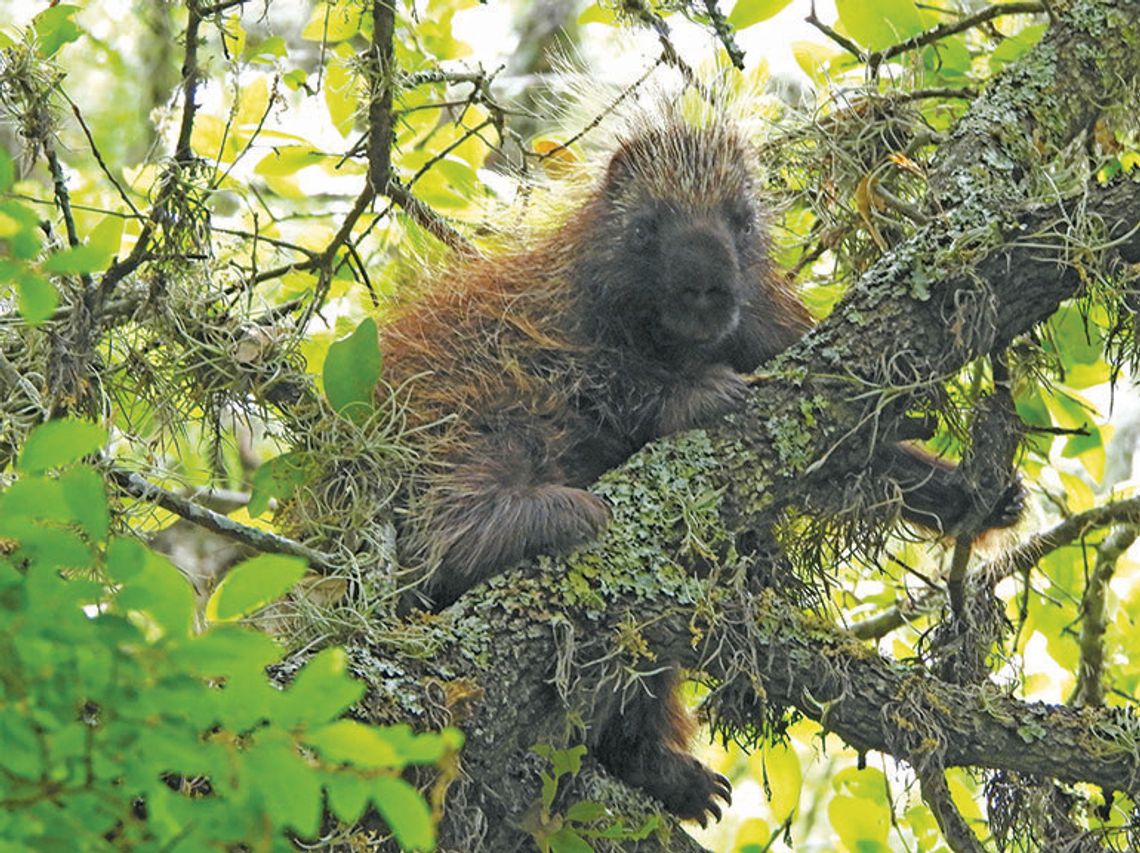CREEKSIDE AT THE CIBOLO
The North American porcupine — the “thorn pig.” Every time I encounter one, the second largest rodent in Texas, it is memorable — from the first I saw as a college freshman outside of Bottineau, North Dakota, in the dead of winter, holding onto a treetop, to the one I encountered today, resting in a treetop along the woodland trail.
Close encounters with this critter, unfortunately, can end badly, particularly for inquisitive pets, in both life and death.
I say death because there was that time when I first moved to the Texas Hill Country and saw a road-killed North American porcupine. First, I was shocked because it never occurred to me that this animal could be in Texas; I thought it was a northern critter of mountains and snow.
Immediately, however, that thought changed from the range as the only North American representative of the family Erethizontidae (don’t hurt yourself trying to pronounce that correctly) to collecting quills for educational purposes.
Months later, long after its death, it struck when a dog I lived with came out of my toolbox with a muzzle and tongue full of quills. It all ended well, but it wasn’t a moment of marital bliss.
The next one I saw was on a hot day in the Chihuahuan desert at the campus of Shumla School west of Del Rio. Again, I wondered how this animal survives in a landscape fairly void of trees.
Yet there it was, tucked under a boulder, taking advantage of the only shade for miles around. It turns out porcupines feed, among other desert plants, on Ocotillo stems, a spiny treat for a spiny animal.
The most famous porcupine I saw was initially identified by my “brilliant naturalist mind” as a squirrel nest ... until that nest came to life and turned its head.
This was my first encounter at Cibolo Nature Center. When I shared the misidentification on social media, it was picked up as far away as North Carolina and Florida (those outlets must’ve been desperate for content during the early COVID days.)
Of course, that wasn’t the only one that got its 15 minutes of fame. As my wife, Terry, and I were setting up to call Barred Owls at the nature center a few years ago, one came crawling over a rock ledge to within a few feet. We excitedly began our Facebook live event a little early so folks could see it — but it, not wanting the limelight, slowly turned around and disappeared.

My next encounter was along the prairie trail at The Cibolo on a lovely evening walk. Reminding me of Winnie the Pooh’s friend Eeyore, one was plodding along the trail in open grassland, not a tree in sight for a hundred yards or more.
I say Eeyore because I always had the impression that walking for him was his least favorite activity; the plodding porcupine must be thinking the same. It turns out that during most of the year, their primary diet is ground vegetation-and the prairie has plenty.
Now, back to today. “My” porcupine was resting in the same oak tree on and off for a few weeks, displacing a roosting Barred Owl. It seems to find the live oak a good place for a nap, stretching out across heavy branches 15 feet up.
You might wonder why I would be so enthralled with a rodent, and a rodent yielding a spiny punch if trifled with, at that. In over 50 years of wandering the wilds of Texas and beyond, I’ve had maybe a dozen encounters. That’s not a lot, so just like those of you who’ve had rare (hopefully) encounters with a rattlesnake, each encounter leads to a memorable experienceand a great story. Porcupines, rattlesnakes and other critters I rarely see keep alive my sense of wonder — my desire to get out into the natural world, knowing there is always the possibility of a chance encounter of the wild kind.
So, the next time you wander the trails of The Cibolo, be sure to look up. You never know when you’ll see a branch of dead leaves, no, wait, a squirrel nest — No, wait — that’s the thorn pig of Cibolo.
And by the way, they don’t throw their quills, lest you still believe that old wives’ tale.
(This article first appeared on The Cibolo Center for Conservation’s website)









Comment
Comments